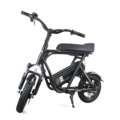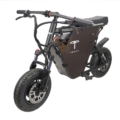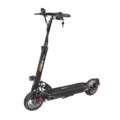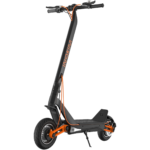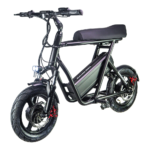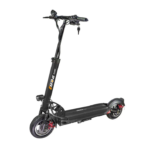- Home
- Scooters
- Electric Scooters
- EMOVE Touring
EMOVE Touring


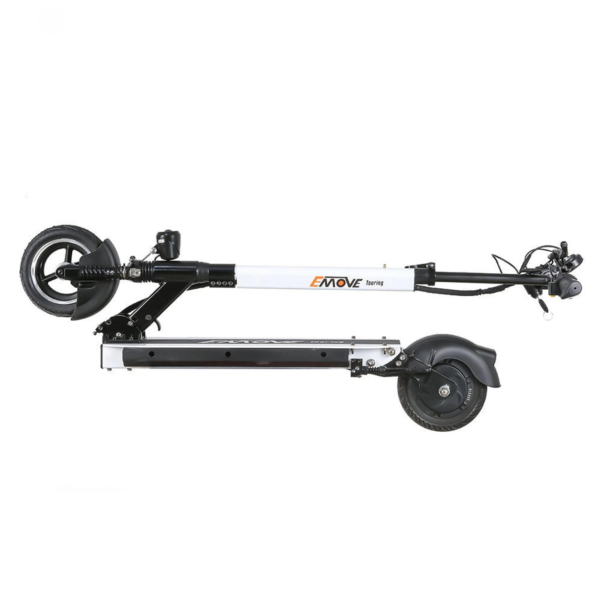
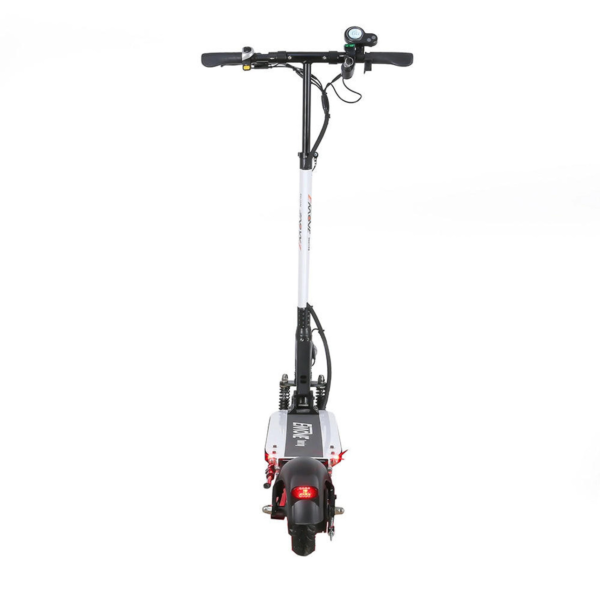
- Battery Range: 32 miles (51 km)
- Top Speed: 25 mph (40.2 km/h)
- Motor Power: 500 W
- Weight Capacity: 308 lb (140 kg)
- Charging Time: ~3–4 h
- Scooter Weight: 39.0 lb (17.7 kg)
PROS
- Portable 39 lb chassis
- 48V 13Ah battery (624 Wh)
- Adjustable telescoping handlebars
- High 308 lb max load for class
- IP54 water resistance
CONS
- Rear drum brake only
- Small 8″ tires ride firmer
- No turn signals
- Less power for steep hills
Key Takeaways
- The EMOVE Touring is a foldable commuter scooter with a 500 W motor and a 48 V battery, ideal for daily travel.
- It features a triple-spring suspension, front pneumatic tire, and rear solid tire for a smooth ride and minimal maintenance.
- Riders can expect a top speed of 25 mph and a range that varies based on conditions and weight.
- With a weight of around 39 lb, the scooter is portable and easy to store, making it suitable for city commuting.
- Security and maintenance tips include regular checks on tire pressure, brakes, and overall cleanliness to ensure longevity.
Table of contents
- What Is the EMOVE Touring?
- How the EMOVE Touring Works
- Key Specifications
- Design & Build Quality
- Performance Fundamentals
- Battery, Range & Efficiency
- Ride Quality & Comfort
- Braking & Safety Features
- Portability & Daily Usability
- Maintenance & Care
- Weather & Seasonal Considerations
- EMOVE Touring vs Alternatives
- Who the EMOVE Touring Is (and Isn’t) For
- FAQs
- Glossary
- Final Notes on Use
The EMOVE Touring is a small, long-range commuter scooter that you can actually carry. It runs a 48-volt battery and a punchy rear hub motor, and it still feels light enough for stairs and trains. So if you want a simple, sturdy ride for city trips, this one lands in a very practical spot.
What Is the EMOVE Touring?
The EMOVE Touring is a foldable scooter built for daily travel. It fits short and mid-length commutes, campus runs, and last-mile hops to bus or rail. You get a 500-watt rear motor and a 48 V, 13 Ah battery, so it moves with pace and keeps weight in check.
The frame uses a telescoping stem and folding bars, so the folded size stays slim. The deck gives real foot room, and the triple-spring suspension smooths rough pavement. Plus, you get a rear drum brake, a front pneumatic tire for grip, and a rear solid tire that shrugs off flats.
Lights sit at the front and rear, and deck LEDs help you stand out from the side. The rated water resistance is IP54, so light rain rides are doable with care. In short, the package feels tough, quick, and easy to live with.
How the EMOVE Touring Works
Most scooters share the same core parts, and this one keeps them simple and proven.
Motor and controller. A 500 W rear hub motor drives the wheel. The controller meters current from the battery and sets how hard the motor pulls. Think of it as the scooter’s brain. It tells the motor when to push and when to relax, then eases off cleanly when you roll out of the throttle.
Battery and BMS. A 48 V lithium-ion pack stores your energy. A battery management system guards the cells during charge and discharge. The pack sits in the deck, so weight stays low for better balance. For example, that low mass helps the scooter feel planted in quick turns.
Throttle. A finger trigger throttle sits on the right bar. You pull it to add speed, and you release it to coast. On long straight paths, cruise control can hold a steady pace, so your hand gets a break.
Brakes. A rear drum brake gives steady, low-maintenance stopping power. The motor adds mild electronic braking when you pull the lever, so you feel extra drag that helps slow the wheel. As a result, short city stops feel calm and predictable.
Lights and display. A bar display shows speed, battery bars, and riding mode. A headlight and tail light raise visibility at dusk and at night. Meanwhile, side deck lights improve your profile from the flanks.
Key Specifications
Below are the core details riders ask about most often. Values show both imperial and metric units, so you can compare at a glance. These specifications define the model’s core character.
General
| Item | Value |
|---|---|
| Model | EMOVE Touring |
| Water resistance | IP54 |
| Frame material | Aluminum alloy |
| Tire size | 8 in front, 8 in rear (20.3 cm, 20.3 cm) |
| Tire type | Front pneumatic, rear solid |
| Suspension | Triple spring (front + dual rear) |
| Brake type | Rear drum with motor assist |
Performance & Power
| Item | Value |
|---|---|
| Motor | 500 W rear hub (peak ~750–800 W) |
| Top speed | Up to 25 mph (40 km/h) |
| Climb capability | City grades in the 7–10% range with momentum |
| Drive | Rear-wheel |
Battery, Charging & Electrical
| Item | Value |
|---|---|
| Battery | 48 V, 13 Ah, 624 Wh |
| Charger | 54.6 V, 2 A |
| Charge time | About 6–7 hours from low to full |
| Display | Bar-mounted LCD with riding modes |
| Cruise control | Yes |
Build & Dimensions
| Item | Value |
|---|---|
| Weight | ~39 lb (17.7 kg) |
| Max load | Up to 308 lb (140 kg) |
| Deck size | ~22 × 7 in (56 × 18 cm) usable area |
| Handlebar width | ~22 in (56 cm) |
| Handlebar height | Adjustable ~32–40 in (81–102 cm) from deck |
| Unfolded size | ~43 × 22 × 47 in (109 × 56 × 119 cm) |
| Folded dimensions | ~43 × 8 × 14 in (109 × 20 × 36 cm) |
Safety & Control
| Item | Value |
|---|---|
| Headlight and tail light | Included |
| Side deck lights | Included |
| Bell | Included |
| Reflectors | Integrated |
Features & Extras
| Item | Value |
|---|---|
| Folding bars | Yes |
| Telescoping stem | Yes |
| Kickstand | Yes |
| Cruise control | Yes |
| On-board settings | Speed modes, display settings |
Warranty & Compliance
| Item | Value |
|---|---|
| Limited warranty | 12 months on major components |
| Water rating | IP54 |
| Compliance | Consumer e-mobility equipment standards, regional rules vary |
Note: Local rules differ by city and region, so check how and where you can ride.
Design & Build Quality
The build leans on smart weight placement and sturdy joints. The deck holds the battery, so mass sits low, and that helps stability. The hinge locks with a firm latch, and the telescoping stem clamps tight when you set your height. Then, when you fold, the bars line up cleanly, so the bundle stays narrow.
You feel the frame’s stiffness during quick lane changes. The deck has a flat top with a grippy surface, and the rear kickplate gives your back foot a solid brace. Cable routing stays tidy along the stem. Meanwhile, the rear drum brake sits inside the hub, so the mechanism is shielded from spray and grit.
Finish quality reads clean. You see even paint, smooth welds, and snug fasteners. The latch and clamps feel positive. Plus, you can dial the stem height so your elbows stay relaxed at cruise. That one tweak makes longer trips easier on your shoulders.
Performance Fundamentals
Power delivery starts smooth, then ramps with a firm push. The first few feet feel gentle, so starts in crowds stay calm. Once rolling, the motor pulls harder, and you reach city speeds quickly. If you want a softer or stronger start, the display lets you adjust. In practice, that keeps the EMOVE Touring friendly for new riders and still lively for experienced ones.
Straight-line stability holds up well at cruising pace. The long deck and rear-wheel drive keep the nose planted when you hit small bumps. The front pneumatic tire grips on worn asphalt, and the rear solid tire tracks predictably on clean pavement. So the ride feels steady in bike lanes and on neighborhood streets.
Hill behavior follows the motor’s size and the tune. Short ramps in the 7–10% range are manageable with a moving start. Steeper grades call for a run-up and a steady stance. You will feel speed fade on long, steep climbs, which is normal for a light commuter. Then, once you crest, the scooter gathers speed again without drama.
Battery, Range & Efficiency
The 48 V, 13 Ah pack offers 624 Wh of energy. That capacity supports real rides of varied lengths. Riders near 165 lb (75 kg) on flat ground at moderate speed can expect long morning and evening trips on one charge. Heavier riders, cold weather, hills, and faster cruising reduce range, so plan some margin into every route.
For example, headwinds, rain, and repeated hill starts draw more current, and that drains the pack faster. Tire pressure matters, too. Under-inflation at the front adds rolling drag, so range drops and the ride feels vague. Keep the front tire at the maker’s suggested PSI to hold grip and reduce losses. For quick targets by rider weight and a plain rundown of tubed, tubeless, and honeycomb tires, check this tire PSI by rider weight guide.
Charging from low to full with the stock 2 A charger takes about 6–7 hours. You can top up at work for the ride home. For day-to-day use, try to keep the pack between 20% and 90%. In practice, that habit eases stress on the cells over time. If you pause riding for a few weeks, store the scooter at room temperature around half charge.
Ride Quality & Comfort
Comfort starts with the suspension. The front spring softens sharp edges from cracks and seams, and the dual rear springs keep the tail from skipping on rough patches. The tune feels supportive rather than soft, so the scooter stays composed on broken pavement.
The front pneumatic tire adds a cushion of air. That air volume smooths chatter and helps the contact patch conform to the road. The rear solid tire trades a bit of bump absorption for peace of mind. You do not deal with rear flats, which saves time for daily riders. Meanwhile, the stem clamps and cockpit keep flex in check, so the bars feel steady.
Ergonomics work for a wide range of heights thanks to the telescoping stem. You can bring the bars up to reduce back hunch, or drop them for a crouched posture. The trigger throttle sits under your index finger, and the single brake lever is easy to reach with the left hand. The deck supports a shoulder-width stance, and the rear kickplate gives a stable anchor on climbs. So longer rides feel easier on wrists and calves.
Braking & Safety Features
The rear drum brake delivers a firm bite with little setup. Drum systems sit inside the hub, so water and grit hit them less than exposed parts. The lever feel is linear, and you can modulate speed with one or two fingers. The motor’s electronic assist adds gentle resistance when you pull the lever, which helps shorten stops at lower speeds. As a result, stop-and-go traffic feels controlled.
Lights cover the basics. A forward light raises your profile to oncoming traffic, and a tail light marks your position from behind. Deck LEDs on the sides improve side-on visibility near driveways and side streets. So drivers and cyclists see you sooner from more angles.
The IP54 rating covers light rain, puddle spray, and damp roads. Deep water, pressure washers, and long storm rides still pose a risk. After wet trips, dry the scooter and check the brake response before your next ride, then store it in a cool, covered spot.
Portability & Daily Usability
At about 39 lb, the EMOVE Touring carries well for a mid-range commuter. The fold latches in seconds, and the bars fold in to make a slim bundle. You can grab the stem at the balance point and lift with one arm for short stairs. Then, at your desk, the narrow folded profile tucks under chairs and fits in many trunks.
Daily living details help. The kickstand flips down with a firm action and holds the scooter upright on level ground. The deck surface wipes clean with a damp cloth. The latch parts look simple and sturdy, so you can inspect them at a glance. A small bell on the bar gives a friendly ping for crowded paths. Plus, the telescoping stem lets family members share the scooter with quick height changes.
Security starts with common sense. Bring the scooter inside when you can. If you must lock outside, use a solid U-lock or chain through the frame and a fixed rack, and remove quick-take items from the bar. For instance, a clip-on light or phone mount should come with you.
Maintenance & Care
Keep a short checklist and you will stay ahead of wear.
- Before rides. Check front tire pressure, lever feel, stem clamp tension, and lights. Then spin the wheels to listen for rubbing.
- Weekly. Wipe down the deck, inspect the folding hinge, and check for fastener movement. Add a quarter-turn to any screw that starts to back out. Do not over-tighten.
- Monthly. Inspect brake shoe wear inside the drum by feel and sound. If the lever pull grows longer, adjust cable tension at the barrel. Next, confirm that the latch pins seat fully.
- Quarterly. Check suspension bolts, stem clamp parts, and latch pins. Clean and lightly lube pivot points with a product safe for plastics and rubber. Afterward, cycle the fold a few times to spread the lube.
- Battery habits. Charge in a dry, ventilated area. Unplug when full. Store around half charge if you will pause riding for several weeks.
For example, a two-minute air pressure check can save tire wear and improve range. That tiny step pays off every week. Meanwhile, a quick clamp check reduces bar play and extends hinge life.
Weather & Seasonal Considerations
Rain changes traction and sight lines. Slow down, brake earlier, and avoid painted lines, metal covers, and smooth stone. Water can hide potholes, so treat puddles with care. After wet rides, dry the scooter and let it breathe before charging.
Heat and cold affect range and comfort. Lithium cells give less energy in low temperatures, and they age faster when stored very hot. So park in the shade in summer and ride with more range margin in winter. Gloves improve lever feel when it is cold, and a clear visor reduces eye strain in rain.
Wind matters more than many expect. A strong headwind raises energy draw at a given speed. Tuck your elbows in and ease the pace to stretch the pack. For instance, a tailwind can make a trip feel easier at the same speed, then a crosswind can nudge the bar, so keep a looser grip.
EMOVE Touring vs Alternatives
Light commuters fight for a balance of speed, weight, and size. The EMOVE Touring sits near the middle of that triangle. It runs faster than entry scooters in the 15–20 mph class, and it stays well below heavy long-range models near 60–70 lb.
A front pneumatic and rear solid tire form a practical pair in cities where punctures are common. Triple springs add more comfort than rigid frames. A rear drum system needs less upkeep than exposed discs on wet winter roads, which many riders like. On top of that, the folding bars and telescoping stem shrink storage headaches.
So when does a different class make more sense? High-power models climb steep hills faster and hold 30+ mph on open roads. Big-wheel commuters with dual pneumatic tires float over broken pavement and feel calmer at higher speed. Ultralight last-mile scooters crush the Touring on weight and suit riders who carry up several floors every day. In short, match your route and storage to the class. If that’s the priority, the Xiaomi Electric Scooter 4 Go is a compact option with simpler hardware and lower weight.
Who the EMOVE Touring Is (and Isn’t) For
The EMOVE Touring fits riders who want one scooter for the daily grind without fuss. City commuters, students on spread-out campuses, and multi-modal travelers get the most from its size and range. The fold and weight help with trains, rideshares, and small apartments. Plus, the adjustable bars make sharing simple in a family or office.
Riders who want very high speed or frequent steep climbs should look at stronger motors and larger batteries. People who ride on broken roads all day may prefer dual pneumatic tires and longer-travel suspension. Those who carry a scooter up many floors every trip may want an ultralight model. Then again, if your routes blend bike lanes, neighborhood streets, and short hills, this scooter hits a sweet spot.
If that sounds like your day, the trip gets simple. You charge at home, fold at the door, and roll out with a calm, stable feel. In practice, that covers a wide slice of city travel.
FAQs
How fast does the EMOVE Touring go?
It tops out near 25 mph, which is about 40 km/h on flat ground with a light to mid-weight rider. So plan your lane choices with that speed in mind.
What range can I expect on one charge?
Plan for city rides that add up to a few dozen miles under steady speeds. Cold, hills, and heavy loads reduce range. For instance, winter mornings can trim several miles off a commute.
Can I ride in the rain?
The rating is IP54. Light rain rides are possible with care, and deep water is off limits. After wet rides, dry the scooter before charging.
How does the folding system work?
You release the stem latch, fold the bar tube toward the deck, and collapse the telescoping section. Then the bars fold in to shrink width.
What kind of maintenance does it need?
Check tire pressure, lever feel, and clamp tightness before rides. Adjust the drum cable when the lever feels longer. Next, inspect fasteners monthly.
Is cruise control available?
Yes. Turn it on in the display menu. Hold a steady throttle and the scooter keeps that speed until you brake or touch the throttle again.
Where can I read an EMOVE Touring overview in one place?
You are reading it here. This page pulls the main facts, ride tips, and setup basics into one spot, so you can keep it handy.
Glossary
Ah (amp-hours). A measure of how much charge a battery can hold. Higher Ah means more stored energy at the same voltage.
Wh (watt-hours). Battery capacity in energy terms. Multiply volts by amp-hours to get Wh.
Controller. The electronic unit that tells the motor how much current to use. Then it adjusts output as conditions change.
Regen. Short for regenerative braking. The motor acts as a generator to slow the wheel and feed a bit of energy back.
Stem flex. Small movement in the steering tube when you hit bumps or brake hard. In practice, tight clamps reduce this feel.
IP rating. Ingress Protection code. IP54 means limited dust entry and spray resistance from any direction.
Trigger throttle. A small lever for your index finger that requests power from the motor.
Drum brake. A brake housed inside the wheel hub that uses shoes to press on an inner drum.
Pneumatic tire. A tire filled with air. It smooths small bumps and adds grip.
Solid tire. A tire made from solid rubber or foam that cannot go flat.
Deck. The standing platform. It houses the battery in most scooters.
Kickplate. The raised rear section of the deck where you brace your foot.
PSI. Pounds per square inch. A unit for tire pressure.
Climb grade. The steepness of a hill, expressed as a percent. Ten percent means a 10-unit rise over 100 units of run.
Cruise control. A mode that holds a constant speed until you brake or change throttle.
Final Notes on Use
This scooter favors riders who want a blend of speed, range, and portability. Set your bar height for a relaxed stance. Keep your front tire at the right PSI. Watch the charge bars and leave some margin in cold weather. With a few small habits, every trip gets smoother.
The EMOVE Touring stays honest about what it is. It is quick, compact, and easy to carry. It will move you through city traffic with less effort and more control than many entry-level options. Treat it well and it will pay you back every day.
Specifications
General
| Model The Model specifies the exact version or name of the scooter. It helps identify its unique design, features, and specifications within the manufacturer’s product line. Knowing the model makes it easier to compare options, find compatible accessories, or look up support information. | Touring |
| Brand The Brand identifies the manufacturer or company that designs and produces the scooter. A trusted brand is a sign of quality, reliability, and good customer support. Well-known brands often have higher standards for safety, performance, and after-sales service, giving you more confidence in your purchase. | EMOVE |
| Release Date The Release Date indicates when the scooter model was officially launched on the market. This helps you know how current the design, technology, and features are. A newer release date often means updated components, improved performance, and the latest safety or smart features. | 18 November 2025 |
| Recommended Age Recommended Age indicates the minimum age range that the scooter is designed for, based on safety, size, and ease of use. Following the recommended age helps ensure that riders can handle the scooter’s speed, weight, and controls comfortably and safely. Always check local laws and use protective gear, especially for younger riders. | +16 |
Performance & Power
| Motor Power (Wattage) What it means: The motor power, measured in watts (W), shows how strong the scooter’s electric motor is. Why it matters: Higher wattage usually means better acceleration, more torque, and improved performance on hills or rough terrain. For example, a 250W motor is good for flat city roads and light riders, while a 500W or 1000W motor provides more power for faster speeds or climbing steep inclines. | Rear hub 500 W BLDC |
| Top Speed The Top Speed indicates the maximum speed that the scooter can reach under optimal conditions. It’s usually measured on level ground with a fully charged battery and an average rider weight. A higher top speed allows you to travel longer distances faster, but always ensure you ride within legal speed limits and your personal comfort zone for safety. | 25 mph (40.2 km/h) |
| Battery Capacity Battery Capacity refers to the total amount of energy the scooter’s battery can store, usually measured in ampere-hours (Ah) or watt-hours (Wh). A higher battery capacity means you can ride longer distances on a single charge, reducing the need for frequent recharging. Keep in mind that actual range can vary depending on rider weight, terrain, speed, and weather conditions. | 48 V 13 Ah (624 Wh) |
| Estimated Range per Charge The Estimated Range per Charge indicates the average distance the scooter can travel on a single full battery charge. This range is calculated under optimal conditions, such as flat terrain, moderate speed, and average rider weight. Real-world range may vary depending on riding style, terrain, weather, and load. A longer range means fewer recharges and greater freedom for longer trips. | 32 miles (51 km) |
| Hill Climb Ability Hill Climb Ability describes the maximum incline or slope that the scooter can handle while maintaining stable performance. It’s typically expressed as a percentage or in degrees. A higher hill climb rating means the scooter can tackle steeper hills without losing too much speed or power. Actual climbing performance may vary based on rider weight, battery charge, and terrain conditions. | 15° |
| Drive System The Drive System refers to how power from the motor is delivered to the wheels. Electric scooters typically use either a hub motor (directly integrated into the wheel) or a chain/belt drive system. A high-quality drive system ensures smooth acceleration, efficient power transfer, and low maintenance. The choice of drive system affects performance, noise level, and overall ride experience. | Rear hub (RWD) |
Charging & Electrical
| Charging Time Charging Time indicates how long it takes to fully recharge the scooter’s battery from empty to 100% using the standard charger provided. Faster charging means less downtime and more time on the road. Actual charging time may vary slightly depending on battery capacity, charger output, and environmental conditions. | Approx. 3–4 hours |
| Battery Type Battery Type refers to the specific technology used in the scooter’s battery, which affects performance, lifespan, weight, and charging time. Most modern electric scooters use high-quality lithium-ion (Li-ion) batteries because they offer a good balance of energy density, durability, and low maintenance. A reliable battery type ensures consistent power delivery and longer riding ranges. | Lithium-ion pack with Smart BMS |
| Removable Battery A Removable Battery means the battery pack can be easily detached from the scooter for convenient charging and replacement. This feature allows you to charge the battery separately, swap it with a spare for extended range, or securely store it indoors in extreme weather. Removable batteries add flexibility and make it easier to keep your scooter powered up wherever you are. | Non-removable internal battery (fixed pack) |
| Regenerative Braking Regenerative Braking is an energy-saving feature that converts some of the energy normally lost during braking back into battery power. When you slow down or brake, the motor works in reverse to generate electricity, which helps extend the scooter’s range and improves overall efficiency. This system also reduces wear on traditional brake components, leading to lower maintenance over time. | Yes (via controller) |
| Lighting Lighting refers to the built-in front and rear lights that enhance visibility and safety when riding in low-light conditions or at night. Good lighting helps you see the road ahead and ensures that other road users can see you. Many scooters include LED headlights, taillights, and sometimes brake lights or side reflectors for added safety and compliance with local traffic regulations. | LED headlight + deck lighting |
Build & Dimensions
| Scooter Weight Scooter Weight refers to the total weight of the scooter when fully assembled, including the battery. This affects how easy it is to carry, lift, and store the scooter when not in use. A lighter scooter is more portable and convenient for commuting, especially if you need to carry it upstairs or onto public transport. Keep in mind that a sturdy frame and quality components may add to the weight but also contribute to better durability and ride stability. | 39.0 lb (17.7 kg) |
| Maximum Rider Weight Maximum Rider Weight indicates the highest rider weight that the scooter is designed to safely support while maintaining optimal performance and stability. Staying within this limit helps ensure reliable acceleration, braking, and climbing ability, and it protects the frame, suspension, and motor from excessive strain. Exceeding the recommended limit may reduce performance and increase wear on components. | 308 lb (140 kg) |
| Deck Size Deck Size refers to the dimensions of the scooter’s standing platform. A wider and longer deck provides more foot space, allowing you to stand comfortably and adjust your stance while riding. A well-sized deck improves balance and stability, especially on longer rides or at higher speeds. Compact decks, on the other hand, help keep the scooter lightweight and portable. | Compact frame; longer deck; stable geometry |
| Handlebar Height Handlebar Height refers to the distance from the deck to the handlebars, which affects your riding posture and comfort. An appropriate handlebar height helps you maintain good balance, reduces strain on your back and arms, and makes steering more comfortable. Some scooters have adjustable handlebars to fit riders of different heights, while others have a fixed height for a streamlined design. | Adjustable (telescoping) |
| Folding Mechanism The Folding Mechanism describes how easily and securely the scooter can be folded for carrying and storage. A well-designed folding system lets you quickly collapse the scooter into a compact size, making it convenient to transport on public transit, store under a desk, or fit into a car trunk. Look for sturdy latches and safety locks to ensure the scooter stays firmly in place when folded or unfolded. | Quick-step folding mechanism |
| Dimensions Folded Dimensions indicate the size of the scooter when it’s fully folded. This measurement shows how much space the scooter will take up when stored or carried, making it easier to check if it will fit in your car trunk, under a desk, or in a closet. Compact folded dimensions are ideal for commuters who need to bring their scooter on public transport or store it in tight spaces. | Folded: 42.9" × 7.9" × 11.4"; Unfolded: Not specified |
| Material Material refers to the primary construction materials used for the scooter’s frame and key components. High-quality materials like aircraft-grade aluminum, reinforced steel, or durable composites provide strength, stability, and a lighter overall weight. A sturdy material ensures the scooter can handle daily wear and tear while maintaining safety and performance. | Aluminum alloy |
Safety & Control
| Brake Type(s) Brake Type(s) describe the braking systems the scooter uses to help you slow down or stop safely. Common brake types include mechanical brakes (like drum or disc brakes), electronic brakes, and foot brakes. Many scooters combine multiple braking systems for added safety and shorter stopping distances. The type and quality of brakes affect your control, especially when riding at higher speeds or on slopes. | Rear drum brake + electronic/regen |
| Suspension Suspension refers to the system that absorbs shocks and vibrations while riding, providing a smoother and more comfortable ride over uneven or rough surfaces. Scooters may have front suspension, rear suspension, or dual suspension for better shock absorption and stability. Good suspension helps reduce rider fatigue and improves control, especially when riding on bumpy roads or off-road paths. | Front spring + rear air suspension |
| Tire Type Tire Type refers to the kind of tires the scooter uses, which directly affects ride comfort, traction, and maintenance. Common types include solid (airless) tires, pneumatic (air-filled) tires, or hybrid options. Pneumatic tires offer better shock absorption and a smoother ride on rough surfaces, while solid tires are puncture-proof and require less upkeep. The right tire type helps ensure safe handling and a comfortable ride in different conditions. | Front 8″ tubeless pneumatic; rear 8″ solid |
| Tire Size Tire Size indicates the diameter and width of the scooter’s tires, which affect ride comfort, stability, and how well the scooter handles different terrains. Larger tires generally offer better shock absorption and a smoother ride over bumps and rough surfaces, while smaller tires keep the scooter lighter and more portable. Choosing the right tire size helps ensure a balance between agility and comfort. | 8-inch |
| Kickstand The Kickstand is a built-in stand that allows you to park your scooter upright when it’s not in use. A sturdy kickstand keeps the scooter stable and prevents it from tipping over, protecting it from scratches and damage. It also makes storing and accessing your scooter more convenient, whether you’re at home, work, or on the go. | Side kickstand |
| Water Resistance Rating Water Resistance Rating indicates how well the scooter is protected against water and moisture, usually shown as an IP (Ingress Protection) rating. This rating helps you understand whether the scooter can handle light rain, splashes, or wet roads without damage. While most scooters are not fully waterproof, a good water resistance rating adds peace of mind when riding in changing weather conditions. Always avoid deep puddles or submerging the scooter to protect its electrical components. | IP54 |
Features & Extras
| Display/Console The Display (or Console) shows important real-time information about your ride, helping you monitor your scooter’s status at a glance. Typical displays show speed, battery level, distance traveled, and riding mode. Some models also include additional features like Bluetooth connectivity, app integration, or backlighting for better visibility at night. A clear and easy-to-read display enhances safety and convenience on every trip. | LCD display with speed, battery, odometer |
| Ride Modes Ride Modes refer to the different speed and power settings you can choose to match your riding style or road conditions. Common modes include eco for maximum range and energy efficiency, standard for everyday balance, and sport or turbo for higher speed and stronger acceleration. Switching between ride modes allows you to customize performance, conserve battery, and ride safely in various environments. | Eco/Normal/Sport (3 modes) |
| Smart App Connectivity Smart App Connectivity lets you pair your scooter with a dedicated mobile app via Bluetooth. Using the app, you can monitor real-time ride stats like speed, battery level, and range, adjust settings such as ride modes or cruise control, lock the scooter for added security, and sometimes receive firmware updates. This feature adds convenience and allows you to personalize your riding experience right from your smartphone. | No dedicated smartphone app |
| Anti-Theft System The Anti-Theft System helps protect your scooter from unauthorized use or theft. This feature can include built-in alarms, electronic motor locks, GPS tracking, or remote locking through a mobile app. A good anti-theft system provides peace of mind when parking your scooter in public spaces, adding an extra layer of security to safeguard your investment. | Keyed ignition + horn |
| Cruise Control Cruise Control allows you to maintain a steady speed without continuously holding the throttle. This feature makes longer rides more comfortable by reducing hand fatigue and providing a smoother, more relaxed riding experience — especially on flat, open roads or bike lanes. For safety, cruise control can usually be easily activated or deactivated while riding. | Yes (cruise control) |
| Accessories Included Accessories Included lists the additional items that come with the scooter to enhance your riding experience and convenience. Common accessories may include a charger, kickstand, bell, lights, phone holder, or carrying strap. These extras add value by making your scooter safer, easier to use, and ready to ride straight out of the box. | Scooter, 48V charger, tools, manual |
Warranty & Compliance
| Warranty Period The Warranty Period indicates how long the manufacturer guarantees the scooter against defects in materials and workmanship under normal use. A good warranty provides peace of mind, showing the brand’s confidence in its product quality. Always check what parts are covered, such as the frame, battery, and motor, and follow the maintenance guidelines to keep your warranty valid. | 12 months (region-dependent) |
| Certifications Certifications confirm that the scooter meets specific safety, quality, and environmental standards set by recognized organizations or regulatory bodies. Common certifications may include CE, RoHS, UL, or other local compliance marks, depending on your region. These certifications ensure that the scooter is manufactured to high standards and is safe and legal to use in your country. | Local micromobility compliance (region-dependent) |


